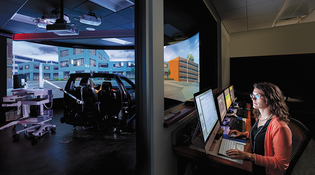 loading
loading
Scene on CampusOff-roadThe only place it's safe to drive while distracted: a Yale simulator.  Bob HandelmanView full imageThe 2007 Mazda 6 in the medical school’s Developmental Neurocognitive Driving Simulation Research Center wouldn’t fetch much at a used-car lot. It’s missing its back half, for starters. But it is the center of a sophisticated setup for recording how people drive in highly realistic simulations. “We can put people in challenging situations, and nobody gets hurt,” says Federico Vaca, a professor of emergency medicine and the center’s director. Test subjects—usually teens and young adults—wear headgear that records their EEGs as they motor through the rural and urban driving courses projected onscreen. In one experiment, drivers had to respond to tones played in their ears by pushing buttons on the steering wheel, to measure the impact of such cognitive tasks on their driving. The lesson? Texting isn’t the only kind of distraction. “It’s not enough to have your eyes on the road,” says Barbara Banz, an assistant professor of emergency medicine at the center. “You have to have your mind on the road.”
The comment period has expired.
|
|